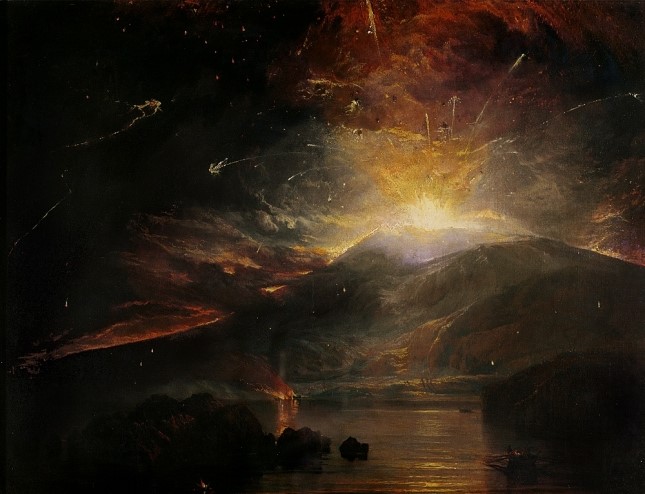The Turner Contemporary opens its doors next month and it promises to be one of the most vibrant places to experience modern art in the south east of England.
The Turner Contemporary opens its doors next month and it promises to be one of the most vibrant places to experience modern art in the south east of England. The feverishly anticipated debut show presents specially commissioned work by the likes of Conrad Shawcross, Ellen Harvey and Daniel Buren, among others, alongside selected works by Douglas Gordon and Teresita Fernández. All of the artists included have their work exhibited in push-and-pull response to a classic painting by Turner that dramatically depicts the eruption of volcano, and the show promises to be nothing short of explosive. AnOther took some time out with curators Victoria Pomery (Director) and Sarah Martin (Head of Exhibitions) to find out why the experience of wonder is the golden thread that binds the works across the abyss of time.
What is the significance of the painting by Turner that the show is centred upon?
Sarah Martin: The drama of the scene depicted in the painting – a volcanic eruption at night, and the sense of wonder and awe it evokes – seemed to suit the occasion of opening a new gallery.
Victoria Pomery: The starting point for the exhibition was that we always wanted to show one key Turner painting alongside contemporary artworks. This is a lesser-known Turner painting and is quite unusual in his oeuvre in that it is based on a sketch by someone else and written accounts in scientific journals, rather than direct observation.
Why do you think Turner was inspired to paint a scene of such drama considering it was an event he hadn't witnessed?
VP: The painting is evocative of the age in which Turner lived: a period of intense scientific discovery and a growing fascination with certain natural phenomena. Of course, recent tragic events in Japan give this an added relevance and poignancy.
SM: Some have also interpreted this painting as being a symbolic commentary on the turbulent political events of the time, in particular the temporary nature of empire. It’s also interesting that this is one of few paintings that Turner, who is primarily known for his depiction of light, made of a night scene. It was an opportunity for him to evoke a different kind of light and to imagine the effects of a volcanic eruption on the night sky.
It’s interesting you talk about wonder. I recently wrote an essay about the emergence of The Wonder Principle in some contemporary art. Do you think there might be a current trend in art to a simple desire to connect with the viewer and inspire wonder?
SM: I don’t necessarily think it’s a current trend. I think there have always been artists interested in engendering this kind of response in the viewer. The flipside of this approach is the tendency of art towards spectacle and entertainment, which could be seen as more of a trend now, for all kinds of reasons. The boundaries between transcendence or wonder and pure spectacle seem increasingly blurred today.
Would you say The Wonder Principle applies to some of the artists you have commissioned in the show?
VP: Absolutely. It depends on one’s definition of wonder, but I would say that, taken very loosely, all the artists in the exhibition represent that principle in different ways. Russell Crotty’s globe drawings and map books, for example, are the result of incredibly detailed observation of the stars, and Daniel Buren’s installation plays with the landscape and the concept of infinity, as well as the changing light visible through the window.
SM: Teresita Fernandez’s work is interesting in this context. Her sculptures and installations evoke aspects of landscape and natural phenomena – not in an attempt to illustrate nature but rather to engage the viewer in the act of looking. For example, her sculpture Eruption gives us a sense of looking into the mouth of a volcano – or rather what we might imagine it to look like from an impossible position over its mouth.
Do you think it's at the borders between what we can know and the truly fantastic that we experience the sublime?
VP: In putting the show together, we did want to highlight that sense of wonder and delight associated with the Sublime, as well as exploring the experiential aspects of contemporary art and the particular experience of passing through a new space. Traditionally the Sublime was about something unfamiliar, something that couldn’t truly be known. The Sublime has meant different things at different points in time. It began as a literary concept, for example.
Do you think Turner was interested in engendering wonder and the Sublime. His rendering of light it almost feels like the archetypal white light of what we tend to call God or Allah...
VP: Yes, absolutely. But I think he was also interested in encouraging a different way of looking, or of seeing the world.
SM: There is the myth of Turner’s deathbed cry ‘The Sun is God!’ That is what Douglas Gordon’s text piece in our exhibition takes as its starting point.
The Turner Contemporary opens 16 April and runs until 4 September 2011.
Text by John-Paul Pryor
